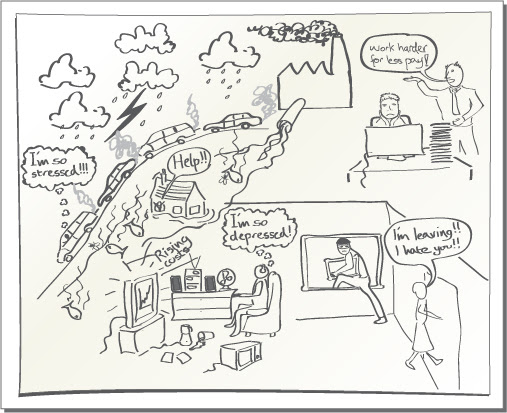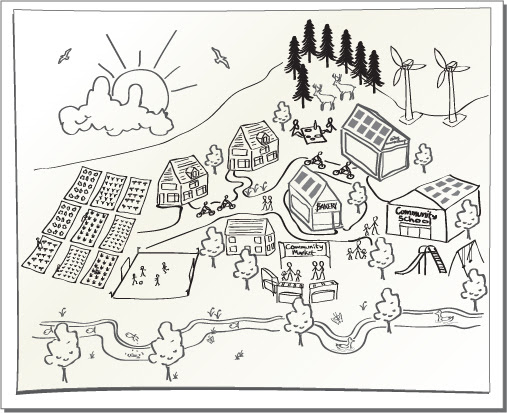A process for visual storytelling
3. Rich pictures - Planting your seed
In this step, we’re going to plant the seed of your story. For this, we first have to fertilise and prepare the soil and then to carefully plant your seed, which we will do by creating a rich picture.
When looking for inspiration for a visual narrative, often a good way to start is by drawing a Rich Picture. A rich picture is a visual brainstorm where you can explore a topic freely, exploring ideas, emotions or thoughts about a certain topic. Rich pictures are a compilation of drawings, pictures, symbols and sometimes text that represent a particular situation or issue from the viewpoint of the person or people who drew them. They can show relationships, connections, influences, cause and effect. They can also show more subjective elements such as character and characteristics as well as points of view, prejudices, spirit and human nature. The idea of using drawings or pictures to think about issues is common to several problem solving or creative thinking methods (including therapy) because our intuitive consciousness communicates more easily in impressions and symbols than in words. Rich pictures can be regarded as pictorial ‘summaries’ of the physical and emotional aspects of the situation at a given time. They are often used to depict complicated situations or issues.
As examples, we developed the rich pictures below to quickly, and visually, brainstorm some of the worries and aspirations of a household that lived next door to one of the authors as they were exploring how they could improve their wellbeing and that of their community. The first rich picture shows some of the concerns the couple had at that moment in time: stressful commuting to work, stuck in traffic; worries about climate change and increasing weather disruptions; decreasing wage package and pension benefits; rising fuel and food prices; decreasing security in the streets and community spirit; increasing consumption of consumer goods; increasing levels of waste and air pollution; leisure time spent alone watching television. All these pressures combined to create a lot of tension and stress within the couple.

The second rich picture shows how we used the rich picture technique to explore what is, and what could, work well in their lives: working locally; contributing towards maintaining a stable and predictable climate (rather than contribute to emissions which will lead to more extreme weather events); higher quality of life reliant on local resources (e.g. growing food locally and generating electricity through solar panels) not dependent on an ever-increasing salary in order to pay rising bills and living costs; fresh air, clean water and open green spaces; more time for spending with family and friends in fun, relaxing, productive, useful activities.

A rich picture offers a great deal of scope for creative thinking and freedom in how you represent your ideas. A lack of drawing skill is no drawback as symbols, icons, photographs and/or text can be used to represent different elements.
Drawing a rich picture is often done most effectively as a communal activity, so that the different stakeholders in a situation can portray things as they see them. They are made up from:
- pictorial symbols
- key words
- cartoons
- sketches and symbols
- a title
It is usually best to avoid too much writing, whether as commentary or as ‘word bubbles’ coming from people’s mouths, although some people find it easier to use short phrases than to try to come up with a pictorial representation of ideas difficult to represent visually.
If you’re interested in a more detailed guide for how to draw a rich picture, you can also watch this video:
